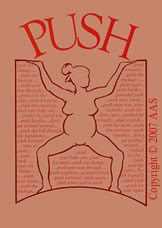There's a lot of talk on another blog (debating homebirth) about "dead babies," but nothing about the loss of maternal life in US hospitals, which is significant. In fact, even the blogger has acknowledged fewer women die birthing at home than do giving birth in the hospital. Let me translate that: ah..h.. hem ... HOMEBIRTH IS SAFER FOR WOMEN!! The margin of difference for neonatal mortality based on the one study is negligible and not substantiated; meanwhile, the maternal mortality rate has increased significantly since 1982 while other countries who embrace midwifery continue to lower. (So, coincidentally, isn't 1982 about the time that epidurals made it big on the scene?) The blogger responds to and about women who choose to birth at home as being uninformed and selfish. It seems pretty smart and giving to me -- especially since all research done on midwifery care in other countries shows both maternal and neonatal mortality rates are lower at home with professional caregiver.
In 1982, the rate was approximately 7.5 deaths per 100,000 live births.
By 2003, that rate had risen to 12.1 deaths per 100,000 births.
The Healthy People 2010 Goal is no more than 3.3 maternal deaths per 100,000 births.
In A Fact Sheet by Ina May Gaskin at www.rememberthemothers.net/home.html#
Historically, midwifery care is shown to decrease maternal mortality around the world.
When will the United States catch up with the rest of the world?
In early 1900's Sweden's maternal mortality rate was 230/100,000 while the US was 700/100,000 and Wales and England were 430. Midwifery skills and family planning lowered the mortality rates dramatically in Sri Lanka from 1500 in the forties to 85/100,000 in 1980's.
Historical records demonstrate the significant improvements that can be achieved when key interventions are in place. Reductions in maternal mortality took place in Sweden during the 1800s, for example, as a result of a national policy favouring professional midwifery care for all births, coupled with establishment of standards for quality of care. By the beginning of the 20th century, maternal mortality in Sweden was the lowest in Europe - around 230 per 100,000 live births compared with over 500 per 100000 in the mid-1880s (10). In Denmark, Japan, Netherlands, and Norway, similar strategies produced comparable results. In England and Wales, significant reductions in maternal mortality were not apparent until the 1930s; at the national level, political commitment to the strategy was achieved only slowly and the introduction of professional midwifery was correspondingly delayed. In every case, however, the key to these improvements was the institution of fully professional maternity care.
http://www.who.int/reproductivehealth/publications/reduction_of
Historical Trends in Maternal Mortality
Standardization of care and treatment of puerperal fever (streptococcus bacteria) were the main factors in improving the maternal mortality rates until the late thirties and continues to be. By early fifties all were around 100/100,000 and the rates in all developed countries dropped dramatically where midwifery care was maintained and developed - Sweden, UK, Netherlands, and Australia. Since 1950 the United States has not continued to decrease the maternal mortality rate as have those countries who have a standard of care that integrates the midwifery model of care for low risk women. The US maternal mortality rate is increasing -- that would be attributed to the "safety of planned, non-medically necessary cesarean" I am theorizing.
Factors other than medical technology as the life saver are involved apparently. Even countries where the GNP was lower, but where midwifery model of care was embraced, the mortality rates for mothers continued to decrease. Higher class women historically have had higher mortality rates than lower class women who gave birth at home. Bottom line is that in the US, having the highest quality and accessibility of medical care does not insure decreased maternal mortality rates - in fact, a woman's chance of dying giving birth in a US hospital is greater than any industrialized nation.
Well, call me selfish if you want to, but after four hospital births between 1975 and 1994, I'd prefer you call me Lucky. Considering I experienced everything EXCEPT a cesarean surgical birth, and my daughter did and survived, you can call me Damn Lucky.
Interference is reported as a major factor in maternal mortality rates.
http://www.ajcn.org/cgi/content/full/72/1/241S. One might say then that interfering with the natural process of birth may contribute to factors that result in higher maternal loss.
Maternal Mortality in the USA: A Fact Sheet
by Ina May Gaskin
- The World Health Organization reported in 2003 that 30 other countries have lower maternal death rates than the United States.
- The Centers for Disease Control (CDC) report that there has been no improvement in the maternal death rate in the United States since 1982.
- The CDC estimated in 1998 that the US maternal death rate is actually 1.3 to three times that reported in vital statistics records because of underreporting of such deaths. (1)
- The CDC reported in 1995 that the “magnitude of the pregnancy-related mortality problem is grossly understated.” (2)
- The rate of maternal death directly related to pregnancy or birth appears to be rising in the United States. In 1982, the rate was approximately 7.5 deaths per 100,000 live births. By 2003, that rate had risen to 12.1 deaths per 100,000 births.
- The CDC estimates that more than half of the reported maternal deaths in the United States could have been prevented by early diagnosis and treatment. (1)
- Autopsies should be performed on all women of childbearing age who die if there is to be complete ascertainment of maternal deaths.
- Numerous studies have found that in 25 to 40 percent of cases in which an autopsy is done, it reveals an undiagnosed cause of death.
- In the 1960s, autopsies were performed on almost half of deaths.
- The United States now does autopsies on fewer than 5 percent of hospital deaths.
- Reporting of maternal deaths in the United States is done via an honor system. There are no statutes providing for penalties for misreporting or failing to report maternal deaths.
- In the United States, the risk of maternal death among black women is about 4 times higher than among white women.
- Most countries with lower maternal death rates than the United States use a different definition of “maternal death”, which, unlike the United States’ definition, includes those deaths directly related to pregnancy or birth which take place during the period between six weeks and one year after the end of pregnancy.
- Complete and correct ascertainment of all maternal deaths is key to preventing maternal deaths.
- The Confidential Enquiry into Maternal Deaths in the United Kingdom (England, Scotland, Wales, Northern Ireland), which has functioned since 1952, is the system believed to have achieved the most complete ascertainment of maternal deaths while guaranteeing utmost confidentiality.
- The maternal mortality rate for cesarean section is four times higher than for vaginal birth and is still twice as high when it is a routine repeat cesarean section without any emergency. (3,4)
- There is currently no federal legislation mandating maternal mortality review at a state level.
Fewer than half of the states conduct state-wide maternal mortality review.
Hospitals do not release reports of maternal deaths to the public; hospital employees are required to keep such information to themselves. - The Healthy People 2010 Goal is no more than 3.3 maternal deaths per 100,000 births.
Notes:
Morbidity and Mortality Weekly Report, September 4, 1998, Vol. 47, No. 34.Atrash HK, Alexander S, Berg CJ. Maternal mortality in developed countries: Not just a concern of the past. Obstet Gynecol 1995;86:700-5. Petitti D et al.In hospital maternal mortality in the United States. Obstet Gynecol, Vol 59, pp. 6-11, 1982. Petitti D.Maternal mortality and morbidity in cesarean section. Clin Obstet Gynecol, Vol. 28, pp. 763-768, 1985.
The Confidential Enquiry into Maternal Deaths in the United Kingdom http://www.cemach.org.uk/
Prepared by Ina May Gaskin, MA, CPM
Coordinator for the Safe Motherhood Quilt Project41
The Farm Summertown, TN 38483
http://www.rememberthemothers.net/http://www.inamay.com/931 964 2519








4 comments:
Thank you for telling the truth. I'm a mom of five homeborn children, and grateful for the care I received. It's not a fully-legal option in my state, but with the abysmal birth outcomes in the US as a whole, you'd think the powers-that-be would consider all options for improving outcomes.
But, follow the money, I guess.
It is sad that there are states that do not allow anyone but doctors to attend births and that women wishing for the safer option of homebirth must do so illegally with a midwife in attendance to receive proper care or go it alone. I am glad that the outcomes of your births went so well and that you followed your heart!
The rest of the world continues to boggle at the US's poor state of healthcare, yet the US is so insular that it continues to view itself as a world leader.
As a very (8 1/2 months) pregnant mother planning a homebirth, there is *no way* I would consider having a baby in the US - looking at US statistics it
s pretty close to third world conditions over there.
However, Australia (where I live) seems to be getting worse and following the US model, with increased interventions and c-section rates. Hence my choice to homebirth.
We're paying a LOT for it - homebirth is not covered by either public health funcding or private insurance, so our costs will be roughly $4-500 all up (about $3,500 US), but to keep away from hospitals we consider the money well spent. And no, we are not wealthy people - the cost is hitting us HARD.
I'll be sure to let you know how our homebirth goes, though! Wish me well!
Daharja
Due February 8 2007.
Dear Daharja, and little One,
Wishing you a gentle, peaceful birth experience and wonderful reconnection in your arms.
I am surprised to hear that homebirth is widely accepted there but not covered by third party payments. It's a big cost, but with untold payoffs. I really believe there is a great value, choice, and responsibility for paying for what one believes in and wants. So many procedures are paid for here by insurance even though the procedure doesn't create huge change or healing. People will keep going to do interventions or drugs that don't help or change becuase they don't have to "pay" for it. People will pay for what is a priority in their lives.
What could be more important than the birth of your baby?
My first child's birth in 1975 cost $300 for the doctor and $300 for the hospital. We made payments for a year. I was so happy when he was "paid in full."
Please keep us posted and let us know when your baby is here in your arms.
Post a Comment